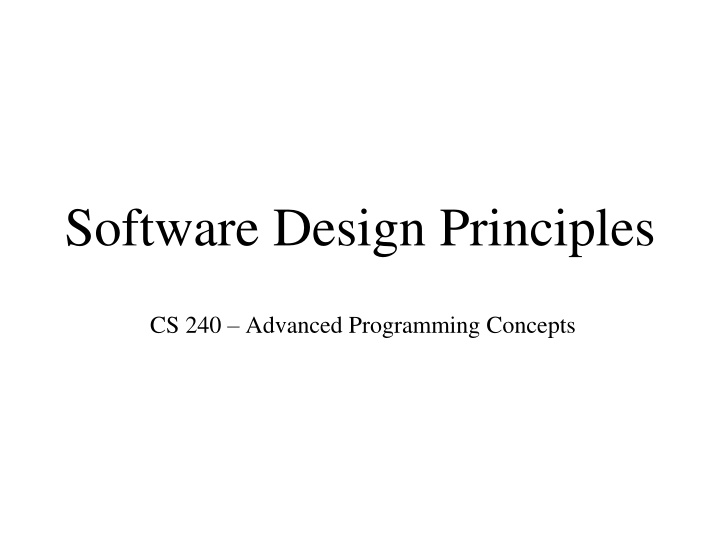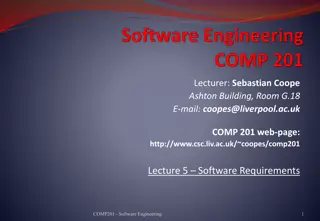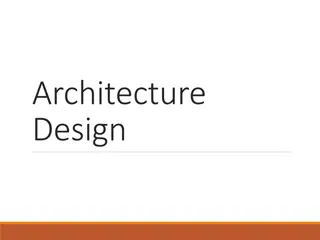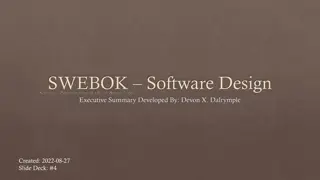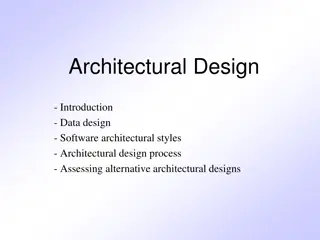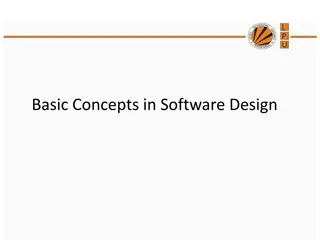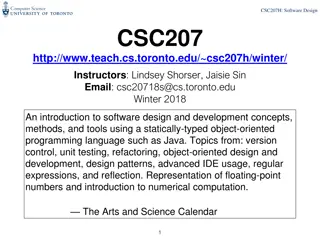Software Design Principles
Essential principles of software design, including iterative processes, abstraction techniques, and the importance of naming conventions. Learn how to create systems that are easy to maintain, adapt to change, and incorporate reusable components to enhance efficiency.
Download Presentation

Please find below an Image/Link to download the presentation.
The content on the website is provided AS IS for your information and personal use only. It may not be sold, licensed, or shared on other websites without obtaining consent from the author.If you encounter any issues during the download, it is possible that the publisher has removed the file from their server.
You are allowed to download the files provided on this website for personal or commercial use, subject to the condition that they are used lawfully. All files are the property of their respective owners.
The content on the website is provided AS IS for your information and personal use only. It may not be sold, licensed, or shared on other websites without obtaining consent from the author.
E N D
Presentation Transcript
Software Design Principles CS 240 Advanced Programming Concepts
Goals of Software Design Create systems that: Work Are easy to understand, debug, and maintain Hold up well under changes Have reusable components 2
Design is Inherently Iterative Design, implement, test, Design, implement, test, Feedback loop from implementation back into design provides valuable knowledge Designing everything before beginning implementation doesn t work Beginning implementation without doing any design also doesn t work The appropriate balance is achieved by interleaving design and implementation activities in relatively short iterations 3
Abstraction Abstraction is one of the software designer s primary tools for coping with COMPLEXITY Programming languages and OSes provide abstractions that model the underlying machine Programs written solely in terms of these low-level abstractions are very difficult to understand Software designers must create higher-level, domain- specific abstractions, and write their software in terms of those High-level abstractions implemented in terms of low-level abstractions 4
Abstraction Some abstractions correspond to real world concepts in the application domain Examples: Bank, Customer, Account, Loan, Broker, Other abstractions do not correspond to real world domain concepts, but are needed for internal implementation Examples: HttpServer, Database, HashTable, 5
Abstraction Each abstraction is represented as a class Each class has a carefully designed public interface that defines how the rest of the system interacts with it A client can invoke operations on an object without understanding how it works internally This is a powerful technique for reducing the cognitive burden of building complex systems 6
Naming A central part of abstraction is giving things names (or identifiers) Selecting good names for things is critical Class, method, and variable names should clearly convey their function or purpose Class and variable names are usually nouns Method names are usually verbs 7
Cohesion / Single Responsibility Each abstraction should have a single responsibility Each class should represent one, well-defined concept All operations on a class are highly related to the class concept Each method should perform one, well-defined task Unrelated or loosely related tasks should be in different methods Cohesive classes and methods are easy to name 8
Decomposition In addition to Abstraction, Decomposition is the other fundamental technique for taming COMPLEXITY Large problems subdivided into smaller sub- problems Subdivision continues until leaf-level problems are simple enough to solve directly Solutions to sub-problems are recombined into solutions to larger problems 9
Decomposition Decomposition is strongly related to Abstraction The solution to each sub-problem is encapsulated in its own abstraction (class or subroutine) Solutions to larger problems are concise because they re expressed in terms of sub-problem solutions, the details of which can be ignored The decomposition process helps us discover (or invent) the abstractions that we need 10
Decomposition Levels of decomposition System Subsystem Packages Classes Methods 11
Algorithm & Data Structure Selection No amount of decomposition or abstraction will hide a fundamentally flawed selection of algorithm or data structure. Examples: Trie data structure for SpellingCorrector Map with pattern keys for EvilHangman 12
Separation of Interface and Implementation Maintain a strict separation between a class interface and its implementation This allows internal details to change without affecting clients Program to interfaces instead of concrete classes 13
Information Hiding Many languages provide public , private , and protected access levels All internal implementation is private unless there s a good reason to make it protected or public A class public interface should be as simple as possible 14
Information Hiding Don t let internal details leak out of a class ClassRoll instead of StudentLinkedList Some classes or methods are inherently tied to a particular implementation. For these it is OK to use an implementation-specific name HashTable TreeSet 15
Code Duplication The DRY principle: Don t repeat yourself Code duplication should be strenuously avoided Identical or similar sections of code Disadvantages of duplication: N copies to maintain Bugs are duplicated N times Makes program longer, decreasing maintainability Solutions Factor common code into a separate method or class Shared code might be placed in a common superclass 16
